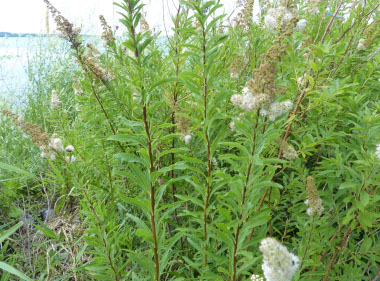
 3
3




 6
6




Find me at http://www.powellacres.com/
 4
4




Argue for your limitations and they are yours forever.
 1
1




Casie Becker wrote:
I think bay leaves are actually "bay laurel" leaves. It's the actual original spice. I have heard of people substituting several native plants for bay leaves, though. Myrtle and Umbellularia californica (which has a huge number of common names including California Laurel) are two of them. Myrtle apparently also has berries that can serve as a substitute for allspice.
Nican Tlaca

 2
2




QuickBooks set up and Bookkeeping for Small Businesses and Farms - jocelyncampbell.com
 2
2




"Also, just as you want men to do to you, do the same way to them" (Luke 6:31)






 1
1




Inge Leonora-den Ouden wrote:You started the thread with asking for a natural herb to replace vanilla. Here we have a wild herb, the English name is Meadowsweet, in Latin Filipendula ulmaria. It seems the root of that plant gives a vanilla-like taste when added to desserts. I did not yet try it, but I have the plant growing near my small pond.
Skandi Rogers wrote:
Vanilla
Meadowsweet (Filipindula ulmaria)
Use in moderation,it contains asprin

The species were in the past sometimes treated in a broad view of the genus Spiraea, but genetic research has shown that they are less closely related than previously considered.

QuickBooks set up and Bookkeeping for Small Businesses and Farms - jocelyncampbell.com
 2
2




Moderator, Treatment Free Beekeepers group on Facebook.
https://www.facebook.com/groups/treatmentfreebeekeepers/





 1
1




"Do the best you can in the place where you are, and be kind." - Scott Nearing
 2
2




Nican Tlaca
 5
5




"Do the best you can in the place where you are, and be kind." - Scott Nearing
 1
1








 2
2




Ken W Wilson wrote:Has anyone used spicebush? I think it’s Lindera Benzoin. The berries,leaves, or bark? I’m sure the berries are used more often.
I don’t have berries yet, but the bushes are big enough to spare some bark. I saw one reference to using it like cinnamon . I couldn’t find any details. The leaves don’t smell like cinnamon but maybe the bark does? Or at least maybe it tastes good.




 1
1




 1
1




 4
4




The fruits (drupes) of Rhus coriaria are ground into a reddish-purple powder used as a spice in Middle Eastern cuisine to add a tart, lemony taste to salads or meat



Invasive plants are Earth's way of insisting we notice her medicines. Stephen Herrod Buhner
Everyone learns what works by learning what doesn't work. Stephen Herrod Buhner
 3
3




 4
4




Anne Miller wrote:Paprika like spice can also be made from Sumac:
The fruits (drupes) of Rhus coriaria are ground into a reddish-purple powder used as a spice in Middle Eastern cuisine to add a tart, lemony taste to salads or meat



"Do the best you can in the place where you are, and be kind." - Scott Nearing




 1
1




With appropriate microbes, minerals and organic matter, there is no need for pesticides or herbicides.




Victor Skaggs wrote:If it's vanilla you're after... some experimentation with sweet clover (Melilotus officinalis) might prove fruitful. It is listed as a medicinal herb, so presumably safe to eat. I know it dried and used as incense (smudge).
It has a very noticeable vanilla flavor. Before flowering, it is impossible to distinguish from alfalfa (also in the Fabaceae family), but its yellow flowers are easy to identify, and the vanilla flavor is strong if you squeeze a leaf between your fingers.
I used to harvest it in New Mexico but haven't seen it yet here (Virginia). I'm on the lookout, though...
I'd be interested to find out if it works as a culinary vanilla substitute.









 1
1




If it's vanilla you're after... some experimentation with sweet clover (Melilotus officinalis) might prove fruitful. It is listed as a medicinal herb, so presumably safe to eat.
Works at a residential alternative high school in the Himalayas SECMOL.org . "Back home" is Cape Cod, E Coast USA.




 1
1




property in Tas, Australia. Sandy / river silt soil.low ph. No nutrients due to leaching. Grazing country. Own water source. Zone 9b.
 2
2




 1
1




"Si hortum in bibliotheca habes, nihil deerit." [If you have a garden and a library, you have everything you need] Marcus Tullius Cicero in Ad Familiares IX, 4, to Varro.
 1
1




growing food and medicine, keeping chickens, heating with wood, learning the land
https://mywildwisconsin.org
 6
6





 1
1




"Jeder nach seinen Fähigkeiten, jedem nach seinen Bedürfnissen"
("From each according to his ability, to each according to his needs")
 3
3




Find me at http://www.powellacres.com/

 1
1




 2
2




 2
2




 1
1





 3
3









|
That's my roommate. He's kinda weird, but he always pays his half of the rent. And he gave me this tiny ad:
The new gardening playing cards kickstarter is now live!
https://www.kickstarter.com/projects/paulwheaton/garden-cards
|







